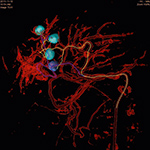Interventional oncology platform for tumour analysis and therapy
Philips’ next generation interventional oncology solution OncoSuite enables physicians to provide analysis and minimally invasive, targeted treatment of tumour lesions reducing the impact to healthy tissue. It offers clinicians a better view of the treatment targets for informed decision making, while performing the procedure. While OncoSuite can be used for a number of different cancers including bone, kidney and lung, the system and its specific tools have been optimized for the treatment of patients with liver cancer. Given the steady increase in the prevalence of non-alcoholic fatty liver disease and liver cancer, the development and availability of new technology is much needed to provide interventional oncologists with a breakthrough that allows best possible treatment for these patients. What matters most in these cases, is the ability to visualize the liver tumours, even small ones, during the procedure and to approach them in a very targeted way to maximize the therapeutic outcome, while avoiding the destruction of healthy liver tissue. OncoSuite is designed to help physicians see, reach and treat liver cancer in a better way. OncoSuite enhances tumour embolization and ablation procedures with Philips’ interventional X-ray systems. It is the only platform in the industry that supports both procedures, enabling physicians to target multiple tumour lesions simultaneously. OncoSuite comprises the company’s innovative product offerings for enhanced imaging (XperCT Dual), live 3D image guidance for tumour embolization (EmboGuide) and live 3D image guidance for tumour ablation (XperGuide). Minimally invasive, image-guided interventional oncology procedures are a highly effective option for patients who cannot be treated through conventional techniques such as surgery, chemotherapy or radiation therapy. Interventional oncology procedures are rapidly increasing and OncoSuite provides the first complete interventional oncology portfolio for interventional radiologists, enabling physicians to see the entire tumour and its feeder vessels to directly target treatment avoiding healthy tissue. The innovative Open Trajectory function within XperCT Dual enables better centering of the liver with significantly improved visualization during the procedure of peripheral hepatic tumours in a single sweep. This feature provides a more targeted field of view making it possible to effectively scan larger patients. Previously, with the traditional geometric movement of the C-arm of the interventional X-ray system, part of the liver image was truncated and larger patients required multiple scans to visualize tumours in the periphery of the liver. Embolization procedures involve blocking the arteries feeding a tumour with beads to deprive it of nutrients and oxygen. They require the insertion of a catheter, which must be guided to the tumour site with the aid of live image-guidance. BTG (Biocompatibles UK Ltd) and Philips have been working in close collaboration on the visualization benefits of radio-opaque beads in combination with image-guided therapy. Together the companies have calibrated LC Bead LUMI and Philips Live Image Guidance Software to help interventional radiologists and multi-disciplinary teams to visualize better treatment options for patients with liver cancer. As a result, the next generation OncoSuite also features the world’s first optimized imaging for LC Bead LUMI that provides real-time visible confirmation of bead location during embolization procedures. In addition, the new Wiper Movement functionality improves workflow with automatic dual phase imaging, helping physicians to acquire two 3D cone beam CT datasets at different times of the procedure in a single step.


